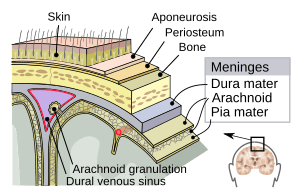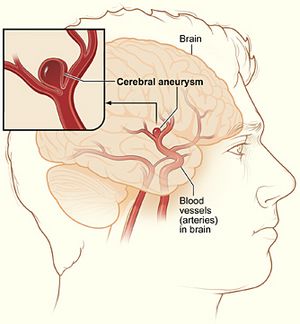Intracranial hemorrhage facts for kids
An intracranial hemorrhage is bleeding inside the brain. "Intracranial" means "inside the skull", and "hemorrhage" means serious bleeding. A very serious type of stroke, called a hemorrhagic stroke, is a kind of intracranial hemorrhage. This happens when bleeding in the brain occurs without a head injury.
When blood vessels in the brain break or get hurt, they bleed. Bleeding inside the brain is very dangerous. If too much blood builds up, it can squeeze or crush the brain. This can also stop oxygen from reaching parts of the brain. Without oxygen, these brain parts can die.
Contents
What Causes Brain Bleeds?
Bleeding in the brain can happen for two main reasons. One reason is a head injury. A bad hit to the head can break some of the blood vessels in the brain.
Brain bleeding can also happen when blood vessels in the brain break without an injury. For example, this can occur if a weak spot in a blood vessel, called a cerebral aneurysm, bursts.
Types of Brain Bleeds

The three most common types of bleeding problems in the brain are epidural hematomas, subdural hematomas, and subarachnoid hemorrhages. These bleeds happen in different parts of the meninges, which are the protective layers covering the brain.
Epidural Hematoma
An epidural hematoma is a collection of blood found between the dura mater (the outermost layer of the meninges) and the skull. "Epidural" means "on top of the dura," and a "hematoma" is a collection of blood.
Usually, head injuries cause epidural hematomas by tearing arteries in the dura. Because these arteries are large, they carry a lot of blood. If one of these arteries is injured, it can bleed very quickly. An epidural hematoma can build up almost right away.
About 15% to 20% of people with epidural hematomas do not survive.
The picture at the top of this page shows an epidural hematoma. The bleeding (light gray area) is between the skull (thick white outer layer) and the rest of the brain (dark gray area).
Subdural Hematoma
A subdural hematoma is a collection of blood under the dura mater. It sits between the dura and the arachnoid layer (the middle layer of the meninges). "Subdural" means "under the dura."
Subdural hematomas are usually caused by head injuries that tear veins. These veins are smaller, and veins do not bleed as fast as arteries. Because of this, subdural hematomas might not bleed as quickly as epidural hematomas.
Subdural hematomas can happen right after a serious head injury. These are called acute subdural hematomas. They are considered the most dangerous type of head injury. About 60% to 80% of people who have them do not survive.

Subdural hematomas can also be chronic. This means they take days or weeks to develop. They are often caused by head injuries that are not very severe. Sometimes, if a vein in the dura slowly leaks blood over time, chronic subdural hematomas can take years to build up.
Subarachnoid Hemorrhage
A subarachnoid hemorrhage is bleeding into the subarachnoid space. This space is located between the arachnoid and the pia mater (the innermost layer of the meninges). "Subarachnoid" means "under the arachnoid."
The subarachnoid space holds cerebrospinal fluid (CSF). When bleeding happens here, blood mixes into the CSF. The blood can irritate the brain and spinal cord. This causes symptoms like a very bad headache and a stiff neck.
Subarachnoid hemorrhages can be caused by head injuries. They can also happen when an aneurysm in one of the blood vessels in the arachnoid layer bursts and starts bleeding.
Subarachnoid hemorrhages are very dangerous. About half of all people with subarachnoid hemorrhages do not survive. About 10% to 15% do not even make it to the hospital. Many people who survive have brain damage.
Related pages
Images for kids
See also
 In Spanish: Hemorragia intracraneal para niños
In Spanish: Hemorragia intracraneal para niños


